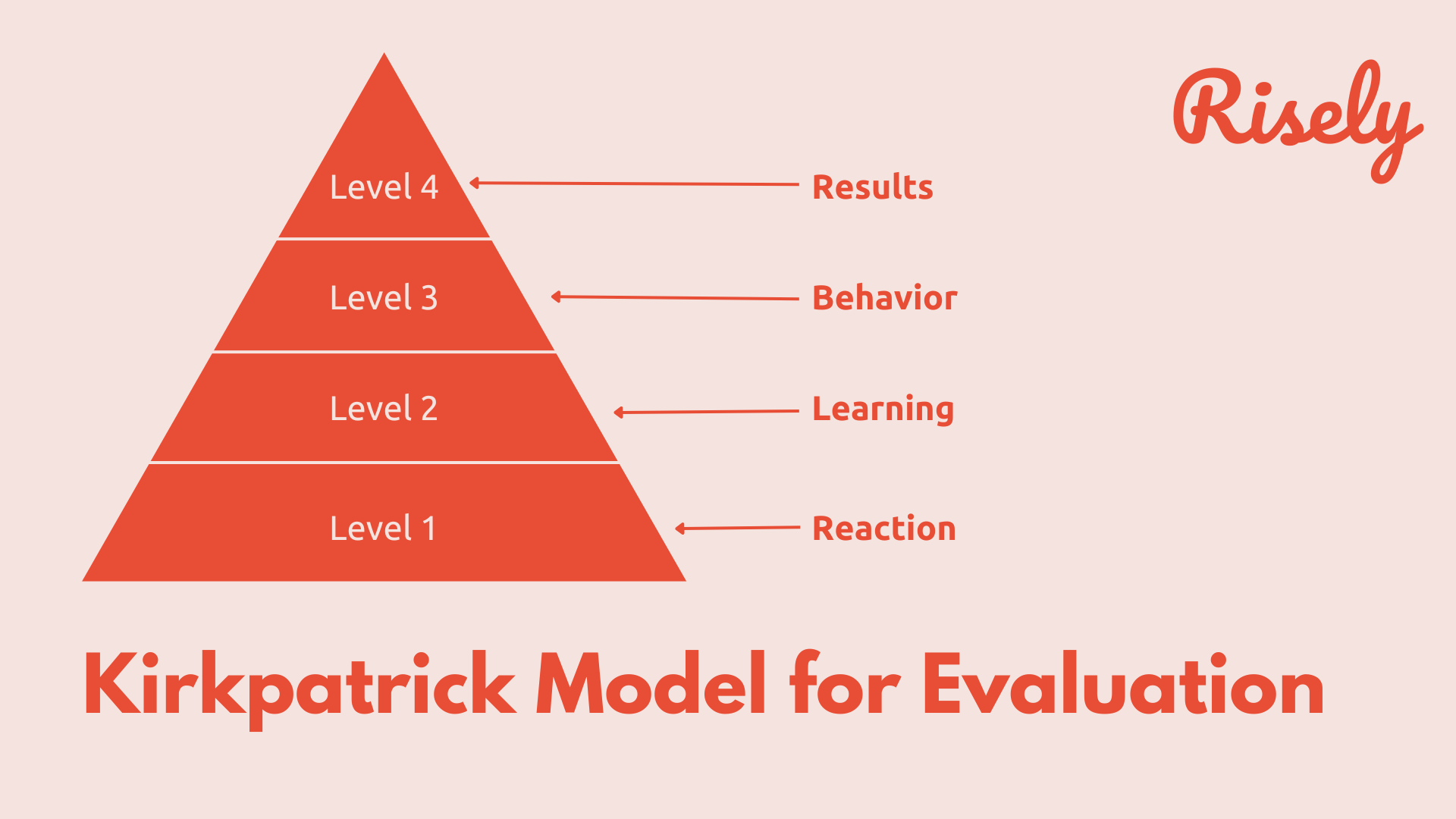What is the Kirkpatrick Model for Evaluation – Know the 4 Levels
Teams must be agile and efficient to stay competitive in today’s fast-paced business environment. One way to do this is by adopting training programs that enhance employee skills and productivity. But how do you know if your training program is effective? The answer lies in the Kirkpatrick Model for Evaluation. Developed by Donald Kirkpatrick, this model outlines four levels of training evaluation: reaction, learning, behavior, and results. In this blog post, we will delve deep into the Kirkpatrick Model for Evaluation – what it is, its benefits and limitations, and how each level of the model measures the effectiveness of a training program. We will also share some key takeaways on how you can implement this model in your organization to evaluate your training programs effectively.What is the Kirkpatrick Model for Evaluation?
The Kirkpatrick Model for Evaluation is a widely used framework for evaluating the effectiveness and impact of learning and development programs. Developed by Donald Kirkpatrick in the 1950s, the model consists of four levels:- Level 1: Reaction – This level focuses on participants’ immediate reactions to the training program, such as their satisfaction and engagement. Feedback can be collected through surveys or interviews to assess participants’ perceptions of the program.
- Level 2: Learning – This level measures how participants have acquired knowledge, skills, or attitudes from the training program. Assessments, tests, or observations can be used to evaluate participants’ learning outcomes.
- Level 3: Behavior – This level examines whether participants apply what they have learned in their work or daily lives. Observations, self-assessments, or supervisor feedback can be used to assess behavior change.
- Level 4: Results – This level evaluates the training program’s impact on organizational goals and outcomes. It involves measuring tangible results such as increased productivity, improved customer satisfaction, or reduced costs.

How does Level 1 of the Kirkpatrick Model measure learner reaction?
Level 1 of the Kirkpatrick Model gauges how learners react to a training program. It evaluates their satisfaction, engagement, and perceived relevance. This assessment is done through surveys or questionnaires immediately after training. While Level 1 feedback can inform future improvements, positive reactions don’t guarantee the learning or application of new skills.What is the focus of Level 2 of the Kirkpatrick Model- Learning?
Level 2 of the Kirkpatrick Model assesses the effectiveness of a training program by evaluating whether participants have acquired new knowledge, skills, or attitudes. It is done through quizzes, tests, simulations, or feedback from trainers or peers. The focus is on measuring the success of the training in achieving its goals and identifying areas for improvement.How does Level 3 of the Kirkpatrick Model measure changes in behavior?
Level 3 of the Kirkpatrick Model assesses how effectively new skills and knowledge have been applied in the workplace. It determines if the training has led to actual behavioral changes through surveys, interviews, or observations. By improving training programs, teams can boost productivity, job satisfaction, and employee retention.What is the significance of Level 4 of the Kirkpatrick Model- Results?
Level 4 of the Kirkpatrick Model evaluates the impact of training programs by measuring changes in behavior, performance, or business outcomes. It helps determine ROI of L&D, identify areas for improvement, and make informed decisions about future investments. Surveys and interviews are usually conducted to collect data for evaluation.Benefits of the Kirkpatrick Model
- Comprehensive Evaluation: The model provides a comprehensive framework for evaluating training programs at multiple levels. It enables organizations to assess the effectiveness and impact of training from various perspectives, including participants’ reactions, knowledge acquisition, behavior change, and business results.
- Alignment with Objectives: The model emphasizes aligning training outcomes with organizational goals. Focusing on the behavior and results levels encourages evaluating how training contributes to desired business outcomes and impacts overall organizational performance.
- Decision-Making Support: The Kirkpatrick model helps organizations make data-informed decisions about their training programs. By systematically evaluating each level, organizations can identify strengths, areas for improvement, and areas of alignment or misalignment with organizational objectives. This information supports decision-making related to program design, resource allocation, and future training initiatives.
- Continuous Improvement: The model promotes a culture of constant learning. By evaluating training programs at multiple levels, organizations can identify gaps and make necessary adjustments to enhance the effectiveness of their training interventions. It supports ongoing learning and refinement of training strategies to ensure they remain relevant and impactful.
Other Interesting Reads
Limitations of the Kirkpatrick Model
- Simplistic View of Causality: The model assumes a linear relationship between the levels of evaluation, suggesting that positive reactions lead to learning, which leads to behavior change and, ultimately, results. The relationship between these levels is complex, influenced by various factors beyond training alone. The model oversimplifies the cause-and-effect relationships in the training process.
- Heavy Focus on Reaction Level: The Kirkpatrick model emphasizes the reaction level, which measures participants’ satisfaction or immediate feedback. While participant feedback is important, relying solely on this level may not provide a comprehensive understanding of the effectiveness or impact of training. It’s crucial to consider other levels, such as behavior and results, to assess performance improvement and business outcomes.
- Limited Guidance on Data Collection: The model does not provide specific guidance on data collection methods or metrics for each level of evaluation. Organizations must determine appropriate measures and evaluation techniques, which can only be challenging with clear guidelines.
- Difficulty in Measuring Results: Evaluating the highest-level results can be complex and difficult. Linking training outcomes to specific business results is often influenced by external factors and requires robust measurement strategies. It can be challenging to isolate the impact of training from other factors that contribute to business outcomes.
- Time and Resource Intensive: Implementing the Kirkpatrick model can be resource-intensive, requiring significant time and effort to collect and analyze data at each level. It may not be practical for organizations with limited resources or those that prioritize efficiency in evaluation processes.
Takeaways to Implement the Kirkpatrick Model for Evaluation
When implementing the Kirkpatrick model for evaluation, it is essential to understand its four levels – reaction, learning, behavior, and results. Determine your objectives first and collect data from various sources like surveys or assessments to evaluate your training programs effectively. Analyze your evaluation metrics meticulously to identify areas where you can improve your training course’s efficacy. By measuring targeted outcomes through interview-style evaluations or control groups’ analysis, you can ensure a higher ROI on your company’s investments in L&D initiatives. Consider these steps when creating a practical learning experience for trainees, employees, and stakeholders.Conclusion
The Kirkpatrick Model for Evaluation is an essential tool to measure the effectiveness of your training. It helps you understand how well your training program has been received and how it has impacted the learners’ behavior. However, like any other model, it has certain limitations. To get the best out of this model, you must clearly understand its four levels and how they work together. It will enable you to evaluate your training program effectively and make necessary improvements. If you want to implement the Kirkpatrick Model in your organization, check out our takeaways from this blog to get started on the right track.Download free Kirkpatrick training evaluation template
Grab your free copy of Risely’s Kirkpatrick training evaluation template today!
What is the Kirkpatrick model of evaluation?
The Kirkpatrick Model of Evaluation is a widely recognized framework for assessing training programs.
What are the 4 levels of assessment?
Its four levels are:
Level 1: Reaction – measuring participants’ satisfaction and feedback.
Level 2: Learning – assessing knowledge, skills, and attitude change.
Level 3: Behavior – evaluating behavior change and application of learning in the workplace.
Level 4: Results – measuring the impact of training on organizational goals and outcomes.
Level 1: Reaction – measuring participants’ satisfaction and feedback.
Level 2: Learning – assessing knowledge, skills, and attitude change.
Level 3: Behavior – evaluating behavior change and application of learning in the workplace.
Level 4: Results – measuring the impact of training on organizational goals and outcomes.
What is an example of the Kirkpatrick model?
An example of the Kirkpatrick Model in action would be assessing the effectiveness of a leadership development program by collecting feedback from participants (Level 1), conducting pre- and post-tests to measure knowledge gain (Level 2), observing changes in leadership behaviors (Level 3), and evaluating the program’s impact on key performance indicators (Level 4).
What does the Kirkpatrick training evaluation model take into consideration?
The Kirkpatrick Training Evaluation Model takes into consideration participant reactions, learning outcomes, behavioral changes, and organizational results. It aims to provide a comprehensive evaluation framework that assesses both individual and organizational impact to determine the effectiveness of training programs.
Other Related Blogs
How to Create a Course with AI: A Guide for L&D Professionals
How to Create a Course with AI: A Guide for L&D Professionals According to a McKinsey survey(1), only 11% of business leaders believe their leadership development initiatives yield meaningful results.…
How to build a Learning and Development Action Plan ft Katie Greenwood
Does your company’s Learning and Development (L&D) strategy feel like more “guessing” than “winning”? You’re not the only one! In today’s fast-changing world, taking a random approach to L&D is…
Generative AI for Learning and Development: Getting Started
Generative AI for Learning and Development: Getting Started In 2024, organizations spent $401 billion globally on corporate training(1), yet 70% of employees report feeling unprepared for the future of work…
Future proofing a learning strategy for organizations with Inna Horvath
Future Proofing a Learning Strategy for Organizations with Inna Horvath With the advent of AI, everyone’s anticipating changes. L&D leaders in charge of building a learning strategy for organizations are…


